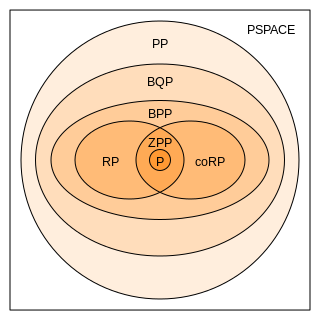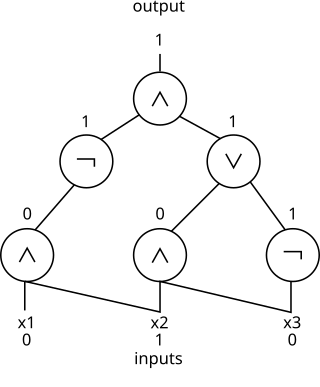In computational complexity theory, a branch of computer science, bounded-error probabilistic polynomial time (BPP) is the class of decision problems solvable by a probabilistic Turing machine in polynomial time with an error probability bounded by 1/3 for all instances. BPP is one of the largest practical classes of problems, meaning most problems of interest in BPP have efficient probabilistic algorithms that can be run quickly on real modern machines. BPP also contains P, the class of problems solvable in polynomial time with a deterministic machine, since a deterministic machine is a special case of a probabilistic machine.

In computational complexity theory, bounded-error quantum polynomial time (BQP) is the class of decision problems solvable by a quantum computer in polynomial time, with an error probability of at most 1/3 for all instances. It is the quantum analogue to the complexity class BPP.
The P versus NP problem is a major unsolved problem in theoretical computer science. Informally, it asks whether every problem whose solution can be quickly verified can also be quickly solved.

In computational complexity theory, NP is a complexity class used to classify decision problems. NP is the set of decision problems for which the problem instances, where the answer is "yes", have proofs verifiable in polynomial time by a deterministic Turing machine, or alternatively the set of problems that can be solved in polynomial time by a nondeterministic Turing machine.
In theoretical computer science, a nondeterministic Turing machine (NTM) is a theoretical model of computation whose governing rules specify more than one possible action when in some given situations. That is, an NTM's next state is not completely determined by its action and the current symbol it sees, unlike a deterministic Turing machine.
In computational complexity theory, the class NC (for "Nick's Class") is the set of decision problems decidable in polylogarithmic time on a parallel computer with a polynomial number of processors. In other words, a problem with input size n is in NC if there exist constants c and k such that it can be solved in time O((log n)c) using O(nk) parallel processors. Stephen Cook coined the name "Nick's class" after Nick Pippenger, who had done extensive research on circuits with polylogarithmic depth and polynomial size.

In computational complexity theory, PSPACE is the set of all decision problems that can be solved by a Turing machine using a polynomial amount of space.
In computational complexity theory, the time hierarchy theorems are important statements about time-bounded computation on Turing machines. Informally, these theorems say that given more time, a Turing machine can solve more problems. For example, there are problems that can be solved with n2 time but not n time, where n is the input length.
The space complexity of an algorithm or a data structure is the amount of memory space required to solve an instance of the computational problem as a function of characteristics of the input. It is the memory required by an algorithm until it executes completely. This includes the memory space used by its inputs, called input space, and any other (auxiliary) memory it uses during execution, which is called auxiliary space.

In theoretical computer science, the time complexity is the computational complexity that describes the amount of computer time it takes to run an algorithm. Time complexity is commonly estimated by counting the number of elementary operations performed by the algorithm, supposing that each elementary operation takes a fixed amount of time to perform. Thus, the amount of time taken and the number of elementary operations performed by the algorithm are taken to be related by a constant factor.

In computational complexity theory, a complexity class is a set of computational problems "of related resource-based complexity". The two most commonly analyzed resources are time and memory.
In computer science, parameterized complexity is a branch of computational complexity theory that focuses on classifying computational problems according to their inherent difficulty with respect to multiple parameters of the input or output. The complexity of a problem is then measured as a function of those parameters. This allows the classification of NP-hard problems on a finer scale than in the classical setting, where the complexity of a problem is only measured as a function of the number of bits in the input. This appears to have been first demonstrated in Gurevich, Stockmeyer & Vishkin (1984). The first systematic work on parameterized complexity was done by Downey & Fellows (1999).
In computational complexity theory, Savitch's theorem, proved by Walter Savitch in 1970, gives a relationship between deterministic and non-deterministic space complexity. It states that for any function ,
In computational complexity theory, P, also known as PTIME or DTIME(nO(1)), is a fundamental complexity class. It contains all decision problems that can be solved by a deterministic Turing machine using a polynomial amount of computation time, or polynomial time.
In computational complexity theory, the polynomial hierarchy is a hierarchy of complexity classes that generalize the classes NP and co-NP. Each class in the hierarchy is contained within PSPACE. The hierarchy can be defined using oracle machines or alternating Turing machines. It is a resource-bounded counterpart to the arithmetical hierarchy and analytical hierarchy from mathematical logic. The union of the classes in the hierarchy is denoted PH.
In computational complexity theory, the complexity class NEXPTIME is the set of decision problems that can be solved by a non-deterministic Turing machine using time .
In computational complexity theory, an advice string is an extra input to a Turing machine that is allowed to depend on the length n of the input, but not on the input itself. A decision problem is in the complexity class P/f(n) if there is a polynomial time Turing machine M with the following property: for any n, there is an advice string A of length f(n) such that, for any input x of length n, the machine M correctly decides the problem on the input x, given x and A.
In computational complexity theory, P/poly is a complexity class representing problems that can be solved by small circuits. More precisely, it is the set of formal languages that have polynomial-size circuit families. It can also be defined equivalently in terms of Turing machines with advice, extra information supplied to the Turing machine along with its input, that may depend on the input length but not on the input itself. In this formulation, P/poly is the class of decision problems that can be solved by a polynomial-time Turing machine with advice strings of length polynomial in the input size. These two different definitions make P/poly central to circuit complexity and non-uniform complexity.

In theoretical computer science, circuit complexity is a branch of computational complexity theory in which Boolean functions are classified according to the size or depth of the Boolean circuits that compute them. A related notion is the circuit complexity of a recursive language that is decided by a uniform family of circuits .
Quantum complexity theory is the subfield of computational complexity theory that deals with complexity classes defined using quantum computers, a computational model based on quantum mechanics. It studies the hardness of computational problems in relation to these complexity classes, as well as the relationship between quantum complexity classes and classical complexity classes.
















